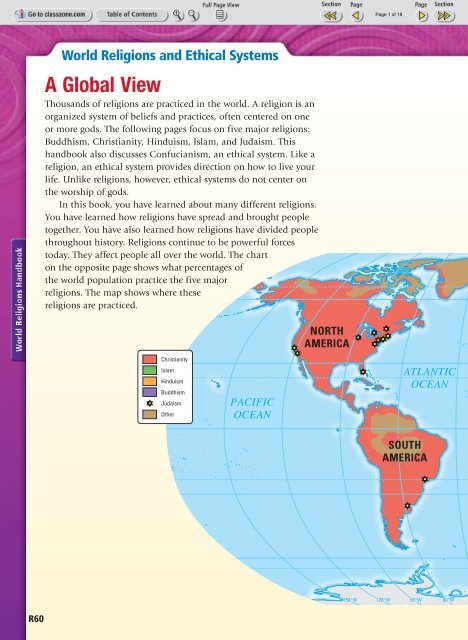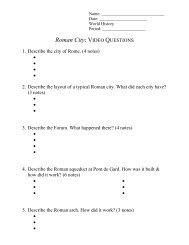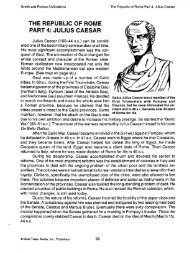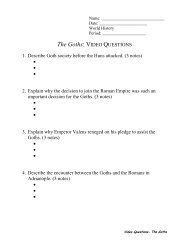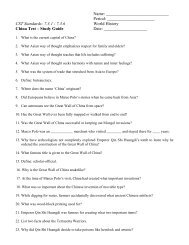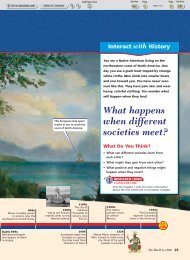World Religions and Ethical Systems
World Religions and Ethical Systems
World Religions and Ethical Systems
Create successful ePaper yourself
Turn your PDF publications into a flip-book with our unique Google optimized e-Paper software.
<strong>World</strong> <strong>Religions</strong> <strong>and</strong> <strong>Ethical</strong> <strong>Systems</strong>A Global ViewThous<strong>and</strong>s of religions are practiced in the world. A religion is anorganized system of beliefs <strong>and</strong> practices, often centered on oneor more gods. The following pages focus on five major religions:Buddhism, Christianity, Hinduism, Islam, <strong>and</strong> Judaism. Thish<strong>and</strong>book also discusses Confucianism, an ethical system. Like areligion, an ethical system provides direction on how to live yourlife. Unlike religions, however, ethical systems do not center onthe worship of gods.In this book, you have learned about many different religions.You have learned how religions have spread <strong>and</strong> brought peopletogether. You have also learned how religions have divided peoplethroughout history. <strong>Religions</strong> continue to be powerful forcestoday. They affect people all over the world. The charton the opposite page shows what percentages ofthe world population practice the five majorreligions. The map shows where thesereligions are practiced.NORTHAMERICAChristianityIslamHinduismBuddhismJudaismOtherPACIFICOCEANATLANTICOCEANSOUTHAMERICA150°W120°W90°W 60°WR60
BuddhismBuddhism is named for its founder, Siddhartha Gautama(sihd•DAHR•tuh GOW•tuh•muh), who came to be knownas the Buddha, or “enlightened one.” According to Buddhisttradition, the Buddha was born into a noble Indian family.But he gave up his riches to seek enlightenment, or wisdom.After long study <strong>and</strong> meditation, the Buddha experiencedhis enlightenment. He believed he knew the true natureof suffering <strong>and</strong> how to put an end to it. He called thisinsight into the nature of suffering The Four Noble Truths.The Buddha believed that his followers could achieveenlightenment by following what he called the NobleEightfold Path. This path involved observing the following:right opinions, right desires, right speech, right action, rightjob, right effort, right concentration, <strong>and</strong> right meditation.Buddhism began in India in the sixth century B.C. Afterthe Buddha’s death, missionaries <strong>and</strong> traders helped spreadthe religion to China, Japan, <strong>and</strong> Korea. Today, the religionhas few followers in India. Most Buddhists live in Sri Lanka,East Asia, Southeast Asia, <strong>and</strong> Japan.▼ Buddha’s DayOne of the most importantfestivals in the Buddhistworld is Buddha’s Day, whichfalls in April or May. On thisholiday, many Buddhistscelebrate the Buddha’s birth,enlightenment, <strong>and</strong> death. Anelephant carries the Buddha’sremains in this Buddha’s Dayprocession in Thail<strong>and</strong>.▼ StupaAfter his death, the Buddha’s ashes were placed in a seriesof dome-shaped monuments called stupas. Each stupa wassurrounded by a railing <strong>and</strong> topped with a square structure.The form of these early stupas became the model for Buddhistshrines, like this one in Sri Lanka.R62
Learn More About BuddhismSymbol According to legend, the Buddha was born withimages of wheels on his h<strong>and</strong>s <strong>and</strong> feet. The Buddha’steaching, known as the dharma, was intended to end thecycle of births <strong>and</strong> deaths. As a result, his teaching cameto be symbolized by a wheel. His followers claimed that the“wheel of the dharma” was set in motion when the Buddhagave his first sermon.▲ Statue of the BuddhaStatues of the Buddha, like this one inIndia, often show the religion’s founder ina thoughtful pose. The statues reflect theBuddha’s inner peacefulness <strong>and</strong> wisdom.Buddhism has many sacred books. These writings,which were recorded after the Buddha’s death,contain his teachings. In the following selection,the Buddha teaches the importance of controllingself <strong>and</strong> one’s own desires.One who conquers himself is greater thananother who conquers a thous<strong>and</strong> timesa thous<strong>and</strong> men on the battlefield. Bevictorious over yourself <strong>and</strong> not over others.When you attain victory over yourself, noteven the gods can turn it into defeat.from the DhammapadaTranslated by Eknath EaswaranChapter Connection For information on Buddhismin ancient China, see Chapter 7.WORLD RELIGIONS AND ETHICAL SYSTEMS • R63
ChristianityChristianity is a monotheistic religion, which means that itsfollowers believe in one God. The religion is based on the life<strong>and</strong> teachings of Jesus, as described in the Bible’s New Testament.Christians regard Jesus as the Son of God. They believe that Jesusdied on the cross <strong>and</strong> was resurrected, or raised to heavenly life.Early followers claimed that the resurrection proved that Jesuswas the man who had come to save all of humankind. After Jesus’death around A.D. 29, his followers began to spread Christianbeliefs. They preached about Jesus’ life <strong>and</strong> teachings. For about2,000 years, the religion continued to exp<strong>and</strong>.Today, Christianity is the largest religion in the world. Its nearly2 billion followers are found all over the globe. Most Christians,however, live in North <strong>and</strong> South America, Europe, <strong>and</strong> Africa.▲JesusThis mosaic in the Byzantine churchof Hagia Sophia, or Holy Wisdom, inIstanbul shows Jesus enthroned inheaven. Images of Jesus often show hishead encircled by a halo <strong>and</strong> his h<strong>and</strong>raised in a blessing.R64Christian ChurchChristians gather in churches for public worship.Church services often include a sermon, songs,<strong>and</strong> prayers. These worshipers have gathered fora Christmas service in the National Cathedral inWashington, D.C.▲
Learn More About ChristianitySymbol The cross is the primary symbol of Christianity.Jesus died on the cross, <strong>and</strong> this image appears in manyChristian churches <strong>and</strong> in religious artwork. The cross remindsChristians that Jesus loved humanity <strong>and</strong> died to save it.▲ MissionariesThroughout the history of Christianity, missionarieshave traveled all over the world in an effort tospread the religion. Today, missionary work ofteninvolves teaching or helping others in some way.This missionary is feeding orphans in India.Before Jesus was put to death on the cross, heate a last supper with his 12 main disciples, orfollowers. At the supper, Jesus compared the breadthey were eating to his body. He compared thewine they drank to his blood. Today, words similarto the following are repeated in the Christianritual of communion, in which bread <strong>and</strong> wine areconsumed in remembrance of Jesus’ death.Now as they were eating, Jesus took bread,<strong>and</strong> blessed, <strong>and</strong> broke it, <strong>and</strong> gave it tothe disciples <strong>and</strong> said, “Take, eat; this ismy body.” And he took a cup, <strong>and</strong> whenhe had given thanks he gave it to them,saying, “Drink of it, all of you; for this is myblood of the covenant [agreement], which ispoured out for many for the forgiveness ofsins. I tell you I shall not drink again of thisfruit of the vine until that day when I drinkit new with you in my Father’s kingdom.”Matthew 26:26–29Chapter Connection For information on the spreadof Christianity in Europe during the Middle Ages, seeChapter 9.WORLD RELIGIONS AND ETHICAL SYSTEMS • R65
HinduismHinduism is one of the oldest religions in the world. It developedin India thous<strong>and</strong>s of years ago. The religion developed out ofthe rituals <strong>and</strong> philosophy set forth in many ancient sacred texts.Hindus believe that a supreme being, known as Brahman, is thesoul of the universe. They also believe that Brahman can be foundwithin every person. Many Hindus worship Brahman in the formof other gods <strong>and</strong> divine beings. They believe that these gods cangrant followers wisdom <strong>and</strong> goodness <strong>and</strong> help them overcomeobstacles. But, above all, Hindus believe that their faith can liberatetheir souls from the repeated cycle of life <strong>and</strong> death. Once free,their souls can achieve a heavenlike state of bliss—the ultimategoal of Hinduism.Hindus can be found in every part of the world today, includingNepal, Africa, Europe, <strong>and</strong> North <strong>and</strong> South America. However, thelargest concentration of followers can be found in India, where 82percent of the population is Hindu.▼ Ganges RiverHindus believe that the water of the GangesRiver is holy. As shown in this photograph,many Hindus travel to the river to bathe <strong>and</strong>pray. They also keep jars of the river’s water intheir homes to bless the dead <strong>and</strong> the dying.R66▲ GuruHindu teachers are called gurus. Gurus,like the one shown here, help Hindus gainthe wisdom they need to free themselvesfrom suffering. Today, many gurus reachtheir followers through Internet sites thatbroadcast their sermons <strong>and</strong> songs.
Learn More About Hinduism▼ GoddessWhen Hindus worship a supreme being infemale form, they often refer to the deity as theGoddess. The Goddess has many names <strong>and</strong>forms but is often called Lakshmi. Shown below,she is the goddess of wealth <strong>and</strong> good fortune.Symbol The syllable Om (or Aum) is spoken at thebeginning <strong>and</strong> end of all Hindu prayers. Om is the mostsacred sound in Hinduism because it is believed to contain allother sounds. The symbol shown here represents the sound.Sacred Hindu texts known as the Upanishads(oo•PAN•uh•SHADZ) are among the oldest Hinduwritings. The following story from one of thesephilosophical works deals with the nature of Brahman.Uddalaka comm<strong>and</strong>ed Shveta-ketu: Bringme a fig from that tree.He replied: Here it is, sir.Split it open.I have split it, sir.What do you see in it?These tiny seeds, sir.Split one of them open, please.I have split it, sir.What do you see in it?Nothing, sir.Yet, my dear boy, from a subtle essence[unseen spirit] which one cannot see, thisgreat fig tree has grown. Have faith, mydear, for that subtle essence is the Soul ofthe whole universe. That is Reality. That isthe Soul. You are that.from The Wisdom of the Forest: Selectionsfrom the Hindu UpanishadsTranslated by Geoffrey ParrinderWORLD RELIGIONS AND ETHICAL SYSTEMS • R67
IslamIslam began to develop in A.D. 610. This is when Islamic traditionstates that the angel Gabriel began to reveal the word of God to amerchant named Muhammad. These revelations were eventuallywritten down in a book called the Qur’an—Islam’s sacred book.They formed the basis for Islamic belief <strong>and</strong> practice. Islam teachesthat there is only one God, called Allah in Arabic. This is the sameGod that is worshiped in Christianity <strong>and</strong> Judaism. The followers ofIslam, called Muslims, show their devotion to God by performingfive ritual duties, also known as the Five Pillars of Islam. Theseduties are faith, prayer, charity, fasting, <strong>and</strong> a pilgrimage to Mecca.Today, Islam is the fastest-growing religion in the world. Manyof the more than 1 billion Muslims live in southwestern <strong>and</strong>central Asia <strong>and</strong> parts of Africa. Followers also live in SoutheastAsia, Europe, <strong>and</strong> the Americas.▼ PilgrimageThe hajj, or pilgrimage to Mecca in SaudiArabia, is one of the Five Pillars of Islam.Believers who are financially <strong>and</strong> physicallyable are expected to make the journey atleast once. Pilgrims carry out many rituals,including circling the Ka’aba, the smallshrine shown to the left in this photograph.R68▲ MosqueAn Islamic house of worship is called a mosque. Allmosques contain a prayer niche, which indicates thedirection in which to pray—always toward Mecca.Many mosques also include the minarets, or towers,seen in this mosque in Turkey. The call to prayer isoften made from these towers.
JudaismJews, the followers of Judaism, believe in one God. In fact, Judaismis probably the oldest monotheistic religion. The first five booksof the Hebrew Bible, called the Torah, set down the basic laws<strong>and</strong> teachings of Judaism. According to the Torah, God chose aHebrew shepherd named Abraham to be the “father” of the Hebrewpeople. Around 1800 B.C., Abraham led his people to a l<strong>and</strong> that hebelieved God had promised them. This l<strong>and</strong> would later be calledIsrael. In 1948, a Jewish state was created on the l<strong>and</strong>.Judaism is the smallest of the world’s major religions, withslightly more than 14 million Jews. But this small religionhas greatly influenced the development of today’s two largestreligions—Christianity <strong>and</strong> Islam.▼ Jewish GhettoDuring the Middle Ages, Jews wereforced to live in special areas of citiescalled ghettos. The areas were namedafter the section of Venice whereJews were forced to live in the 16thcentury. This synagogue, the Jewishhouse of worship, is located in theJewish ghetto in Venice.▲ HanukkahAccording to legend, the mid-winter holidayof Hanukkah celebrates the miracle of an oillamp that burned for eight days instead of one.For eight days, Jews observe the holiday withprayers <strong>and</strong> rituals. Jewish children, like thoseshown here, play a traditional game with adreidel, a sort of spinning top.R70
Learn More About Judaism▼ MosesAccording to the Torah, Moses led the Hebrewsout of slavery in Egypt. During the journey,Moses received the Ten Comm<strong>and</strong>ments fromGod. The comm<strong>and</strong>ments set down manymoral laws for all of humanity. This paintingshows Moses holding the Ten Comm<strong>and</strong>ments.Symbol A major symbol of Judaism is the Star of David.The six-pointed star honors King David, who ruled ancientIsrael around 1000 B.C. <strong>and</strong> ushered in its golden age.The Hebrew Bible contains writings about Jewishhistory <strong>and</strong> culture. However, it also containsmany stories that are important to other people aswell. The Book of Genesis is the first book of theHebrew Bible <strong>and</strong> of the Torah. It tells the historyof the Jewish people. It also includes the story ofthe creation of the world.In the beginning God created the heavens<strong>and</strong> the earth. The earth was without form<strong>and</strong> void, <strong>and</strong> darkness was upon the face ofthe deep; <strong>and</strong> the Spirit of God was movingover the face of the waters.And God said, “Let there be light”; <strong>and</strong>there was light. And God saw that the lightwas good; <strong>and</strong> God separated the light fromthe darkness. God called the light Day, <strong>and</strong>the darkness he called Night. And there wasevening <strong>and</strong> there was morning, one day.Genesis 1:1–5Chapter Connection For information on Jews inMedieval Europe, see Chapter 10.WORLD RELIGIONS AND ETHICAL SYSTEMS • R71
ConfucianismConfucianism is an ethical system based on the teachings of anancient Chinese scholar named Confucius. Confucius believed thatsociety should be organized around five basic relationships. Theseare the relationships between (1) ruler <strong>and</strong> subject, (2) father <strong>and</strong>son, (3) husb<strong>and</strong> <strong>and</strong> wife, (4) elder brother <strong>and</strong> junior brother,<strong>and</strong> (5) friend <strong>and</strong> friend. Confucius believed that the properconduct of these relationships would create a harmonious societyfounded on goodness. His ideas became the foundation of Chinesethought for more than 2,000 years.Confucianism was never a religion, but it has greatly influencedpeople’s spiritual beliefs. Many Chinese <strong>and</strong> other people in EastAsia combine the religious practice of Buddhism with the teachingsof Confucianism.▼ Celebration for ConfuciusAlthough no one knows exactly the daywhen Confucius was born, many peoplein East Asia celebrate his birthday onSeptember 28. Here, performers in traditionaldress take part in Confucius’ birthdaycelebration.▲ ConfuciusConfucius was born in 551 B.C., during a timeof crisis in China. He hoped his ideas <strong>and</strong>teachings would restore the order of earliertimes to his society. This painting showsConfucius with some of his followers.R72
Learn More About Confucianism▼ Golden RuleConfucius taught that people should treatothers with respect <strong>and</strong> live by the golden rule.The characters in this ink-stamp spell out therule “Do not do unto others what you wouldnot want others to do unto you.”Symbol The harmony that Confucius hoped to achieveis represented by the yin-<strong>and</strong>-yang symbol. The symbolrepresents opposite forces in the world working together.Yin represents all that is cold, dark, soft, <strong>and</strong> mysterious.Yang is the opposite—warm, bright, hard, <strong>and</strong> clear.During his lifetime, Confucius never had enoughpower to put his ideas into practice. But after hisdeath, Confucius’ students spread his teachings.In the 400s B.C., they collected his teachingsin a book called the Analects. In the followingselections from the Analects, Confucius is referredto as the Master.The Master cut out four things. He nevertook anything for granted, he never insistedon certainty, he was never inflexible <strong>and</strong>never egotistical. (9.4)The Master said: “Regard loyalty <strong>and</strong> goodfaith as your main concern. Do not makefriends of those who are not up to yourown st<strong>and</strong>ard. If you commit a fault, do notshrink from correcting it.” (9.25)The Master said: “If one loves someone,can one avoid making him work hard? Ifone is loyal to someone, can one avoidinstructing him?” (14.7)from the AnalectsTranslated by Raymond DawsonChapter Connection For more about Confucianism,see Chapter 7.WORLD RELIGIONS AND ETHICAL SYSTEMS • R73
Other Important <strong>Religions</strong>In addition to the five major world religions you have learnedabout, there are many other important religions. Among theseare Bahaism, Shinto, Sikhism, <strong>and</strong> Zoroastrianism. Two of thesereligions—Shinto <strong>and</strong> Zoroastrianism—are especially importanthistorically because they are ancient. All of the religions aresignificant today because they have many followers.▼ ShintoShinto is the oldest surviving religion ofJapan. It is based on the worship of nature.Shintoists believe that spirits, called kami,are found throughout nature. They worshipthese spirits at shrines in their homes <strong>and</strong> inpublic shrines. The torii, or gate, shown heremarks the entrance to a Shinto shrine. Mostof the nearly 3 million Shintoists practicingtoday live in Japan. Many combine Shintowith Buddhism or Confucianism.▲ BahaismBahaism (buh•HAH•IHZ•uhm) was foundedin Persia in 1863 by a man known asBahaullah, which means “splendor of God”in Arabic. The religion’s founder was believedto be the most recent in a line of messengerssent by God to teach people moral behavior.Above all, the founder taught that Godwants all the different people of the worldto form a single, united society. People’sdifferences <strong>and</strong> their unity are symbolized bythe Baha’i (bah•HAH•ee) houses of worship,which have nine sides <strong>and</strong> a central dome.Worshipers here are entering the Baha’ihouse of worship in New Delhi, India.R74
▲SikhismSikhism (SEEK•IHZ•uhm) is one of the religionsof India <strong>and</strong> was founded over 500 years agoby Guru Nanak, a man raised in the Hindutradition. The religion’s followers are calledSikhs, which means “disciples.” Sikhs believein one God who created the universe <strong>and</strong>who is present everywhere. They believe thatby living a good <strong>and</strong> simple life they can freethemselves from the cycle of life <strong>and</strong> death.The Golden Temple in India, shown here, is theholiest Sikh shrine for the religion’s nearly 24million followers.▲ ZoroastrianismA prophet from Persia (present-day Iran)named Zoroaster founded Zoroastrianism(ZAWR•oh•AS•tree•uh•NIHZ•uhm) around600 B.C. The religion teaches a belief in onegod, Ahura Mazda (ah•HUR•uh MAZ•duh).Followers must obey this god, who willjudge them when they die. Today, many ofthe world’s nearly 2.5 million Zoroastriansmake a pilgrimage <strong>and</strong> pray at this templebuilt in a mountain in southern Iran.WORLD RELIGIONS AND ETHICAL SYSTEMS • R75
Comparing <strong>World</strong> <strong>Religions</strong><strong>and</strong> <strong>Ethical</strong> <strong>Systems</strong>Buddhism Christianity Hinduism Islam Judaism ConfucianismFollowersworldwide(estimated2003 figures)Name ofgod364 million 2 billion 828 million 1.2 billion 14.5 million 6.3 millionno god God Brahman Allah God no godFounder the Buddha Jesus Christ no one founder no founderbut spread byMuhammadAbrahamConfuciusHoly bookmany sacredbooks,including theDhammapadaBible, includingOld Testament<strong>and</strong> NewTestamentmany sacredbooks, includingthe UpanishadsQur’anHebrew Bible,including theTorahAnalectsClergy Buddhist monks priests,ministers,monks, <strong>and</strong>nunsBrahmin priests,monks, <strong>and</strong> gurusno clergy but ascholar class,called theulama, <strong>and</strong>imams, who maylead prayersrabbisno clergyBasicbeliefs• Followerscan achieveenlightenment byunderst<strong>and</strong>ingThe Four NobleTruths <strong>and</strong> byfollowing TheNoble EightfoldPath of rightopinions, rightdesires, rightspeech, rightaction, right job,right effort, rightconcentration,<strong>and</strong> rightmeditation.• There is onlyone God, whowatches over<strong>and</strong> cares forhis people.• Jesus Christis the Son ofGod. He died tosave humanity.His death <strong>and</strong>resurrectionmade eternallife possible forothers.• The soulnever dies but iscontinually rebornuntil it becomesenlightened.• Persons achievehappiness <strong>and</strong>enlightenmentafter they freethemselves fromtheir earthlydesires.• Freedom fromearthly desirescomes frommany lifetimesof worship,knowledge, <strong>and</strong>virtuous acts.• Personsachieve salvationby following theFive Pillars ofIslam <strong>and</strong> livinga just life. Thepillars are faith,prayer, charity,fasting, <strong>and</strong>pilgrimage toMecca.• There is onlyone God, whowatches over<strong>and</strong> cares for hispeople.• God loves<strong>and</strong> protects hispeople but alsoholds peopleaccountable fortheir sins <strong>and</strong>shortcomings.• Persons serveGod by studyingthe Torah <strong>and</strong>living by itsteachings.• Social order,harmony, <strong>and</strong>good governmentshould be basedon strong familyrelationships.• Respectfor parents<strong>and</strong> elders isimportant to awell-orderedsociety.• Education isimportant for thewelfare of boththe individual<strong>and</strong> society.Source: <strong>World</strong> Almanac 2004R76
ReviewMAIN IDEASBuddhism (pages R62–R63)1. Who was the Buddha?2. What is the Noble Eightfold Path?Christianity (pages R64–R65)3. Why was the resurrection important toearly Christians?4. How did Christian beliefs spread?Hinduism (pages R66–R67)5. Why is Brahman important to Hindus?6. What is the ultimate goal of Hinduism?Islam (pages R68–R69)7. What does the Qur’an contain?8. What is the hajj?Judaism (pages R70–R71)9. Who is Abraham?10. What other religions has Judaisminfluenced?Confucianism (pages R72–R73)11. Why is Confucius an important figure inChina?12. What was Confucius’ golden rule?Other Important <strong>Religions</strong> (pages R74–R75)13. Of the four religions discussed on thesepages, which are the oldest?14. How do Sikhs believe they can free themselvesfrom the cycle of life <strong>and</strong> death?CRITICAL THINKING15. UNDERSTANDING CAUSE ANDEFFECT According to the Buddha, whathappens when someone underst<strong>and</strong>sthe true nature of suffering?16. COMPARING AND CONTRASTING Inwhat ways are Christianity, Islam, <strong>and</strong>Judaism similar?17. SUMMARIZING What concept inmonotheistic religions is most likeBrahman in Hinduism?18. DRAWING CONCLUSIONS How do youknow that Confucius valued the family?St<strong>and</strong>ards-Based AssessmentInterpreting a Pie Chart The pie chartbelow shows what percentages of thepopulation of North America practice themajor religions. Use the pie chart to answerthe following questions.North AmericaPopulation’s Religious Affiliations2% Judaism2% Islam1. Which religion is practiced by themost people in North America?A. JudaismB. HinduismC. ChristianityD. Buddhism2. Which two religions are eachpracticed by 2 percent of thepopulation in North America?A. Buddhism <strong>and</strong> HinduismB. Islam <strong>and</strong> JudaismC. Christianity <strong>and</strong> JudaismD. Buddhism <strong>and</strong> IslamTest PracticeClassZone.com12%Other84%ChristianityAdditional Test Practice, pp. S1–S33Source: <strong>World</strong> Almanac 2003WORLD RELIGIONS AND ETHICAL SYSTEMS • R77


